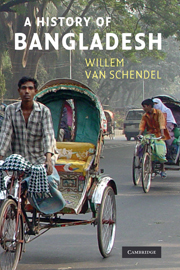Book contents
- Frontmatter
- Contents
- List of plates
- List of maps and figures
- Acknowledgements
- Timeline
- Introduction
- PART I THE LONG VIEW
- PART II COLONIAL ENCOUNTERS
- 5 From the Mughal empire to the British empire
- 6 The British impact
- 7 A closing agrarian frontier
- 8 Colonial conflicts
- 9 Towards Partition
- 10 Partition
- PART III BECOMING EAST PAKISTAN
- PART IV WAR AND THE BIRTH OF BANGLADESH
- PART V INDEPENDENT BANGLADESH
- Conclusion
- Bangladesh district maps
- Key political figures since 1947
- Glossary of Bengali terms
- Notes
- Bibliography
- Index
5 - From the Mughal empire to the British empire
Published online by Cambridge University Press: 05 February 2015
- Frontmatter
- Contents
- List of plates
- List of maps and figures
- Acknowledgements
- Timeline
- Introduction
- PART I THE LONG VIEW
- PART II COLONIAL ENCOUNTERS
- 5 From the Mughal empire to the British empire
- 6 The British impact
- 7 A closing agrarian frontier
- 8 Colonial conflicts
- 9 Towards Partition
- 10 Partition
- PART III BECOMING EAST PAKISTAN
- PART IV WAR AND THE BIRTH OF BANGLADESH
- PART V INDEPENDENT BANGLADESH
- Conclusion
- Bangladesh district maps
- Key political figures since 1947
- Glossary of Bengali terms
- Notes
- Bibliography
- Index
Summary
On a fine June day in 1757 thousands of men were fighting in a mango orchard close to the border of present-day Bangladesh. This battle became famous as a turning-point in the history of South Asia. It took place in the small village of Polashi (‘Plassey’, palāsi), and the encounter established the British East India Company as the new territorial overlord over Bengal. Within a century this trading conglomerate would capture practically all of South Asia. Historians have often described the Battle of Polashi as the beginning of British colonial rule in South Asia, a rule that would last till 1947.
In many ways Polashi is a useful marker of change. It brought to an end a style of government that the Mughal state had introduced some 150 years previously. British rule introduced new ideas, arrangements and coercions that would shake Bengal's society profoundly. But these changes did not occur all at once, nor were they clustered tightly around the year 1757.
In Indian nationalist history writing, Polashi is often used as a marker of South Asian ignominy, when foreigners took control of the state and a colonial system of exploitation took effect. According to this narrative, it took an anti-colonial struggle to remove this blot on the national escutcheon: the colonial state was dismantled and sovereign power returned to indigenous rulers in 1947. From the perspective of Bangladesh history, however, this representation of Polashi is less helpful. First, in the delta foreign rule long preceded the British conquest.
- Type
- Chapter
- Information
- A History of Bangladesh , pp. 49 - 56Publisher: Cambridge University PressPrint publication year: 2009



